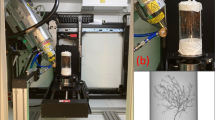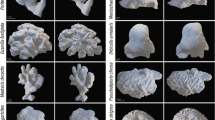Abstract
The surface area of corals represents a major reference parameter for the standardization of flux rates, for coral growth investigations, and for investigations of coral metabolism. The methods currently used to determine the surface area of corals are rather approximate approaches lacking accuracy, or are invasive and often destructive methods that are inapplicable for experiments involving living corals. This study introduces a novel precise and non-destructive technique to quantify surface area in living coral colonies by applying computed tomography (CT) and subsequent 3D reconstruction. Living coral colonies of different taxa were scanned by conventional medical CT either in air or in sea water. Resulting data volumes were processed by 3D modeling software providing realistic 3D coral skeleton surface reconstructions, thus enabling surface area measurements. Comparisons of CT datasets obtained from calibration bodies and coral colonies proved the accuracy of the surface area determination. Surface area quantifications derived from two different surface rendering techniques applied for scanning living coral colonies showed congruent results (mean deviation ranging from 1.32 to 2.03%). The validity of surface area measurement was verified by repeated measurements of the same coral colonies by three test persons. No significant differences between all test persons in all coral genera and in both surface rendering techniques were found (independent sample t-test: all n.s.). Data analysis of a single coral colony required approximately 15 to 30 min for a trained user using the isosurface technique regardless of the complexity and growth form of the latter, rendering the method presented in this study as a time-saving and accurate method to quantify surface areas in both living coral colonies and bare coral skeletons.








Similar content being viewed by others
References
Babcock RC (1991) Comparative demography of three species of scleractinian corals using age- and size-dependent classifications. Ecol Monogr 61:225–244
Bak RPM, Meesters EH (1998) Coral population structure: the hidden information of colony size-frequency distributions. Mar Ecol Prog Ser 162:301–306
Beuck L, Vertino A, Stepina E, Karolczak M, Pfannkuche O (2007) Skeletal response of Lophelia pertusa (Scleractinia) to bioeroding sponge infestation visualised with micro-computed tomography. Facies 53:157–176
Bosscher H (1993) Computerized tomography and skeletal density of coral skeletons. Coral Reefs 12:97–103
Bythell JC, Pan P, Lee J (2001) Three-dimensional morphometric measurements of reef corals using underwater photogrammetry techniques. Coral Reefs 20:193–199
Cocito S, Sgorbini S, Peirano A, Valle M (2003) 3-D reconstruction of biological objects using underwater video technique and image processing. J Exp Mar Biol Ecol 297:57–70
Courtney LA, Fishera WS, Raimondoa S, Olivera LM, Davisa WP (2007) Estimating 3-dimensional colony surface area of field corals. J Exp Mar Biol Ecol 351:234–242
Done TJ (1981) Photogrammetry in coral ecology: a technique for the study of change in coral communities. Proc 4th Int Coral Reef Symp 2:315–320
Fisher WS, Davis WP, Quarles RL, Patrick J, Campbell JG, Harris PS, Hemmer BL, Parsons M (2007) Characterizing coral condition using estimates of three-dimensional colony surface area. Environ Monit Assess 125:347–360
Glynn PW, D’Croz L (1990) Experimental evidence for high temperature stress as the cause of El Nino-coincident coral mortality. Coral Reefs 8:181–191
Goffredo S, Mattioli G, Zaccanti F (2004) Growth and population dynamics model of the Mediterranean solitary coral Balanophyllia europaea (Scleractinia, Dendrophylliidae). Coral Reefs 23:433–443
Hacker BR, Kirby SH (1993) High-pressure deformation of calcite marble and its transformation to aragonite under non-hydrostatic conditions. J Struct Geol 15:1207–1222
Hoegh-Guldberg O (1988) A method for determining the surface area of corals. Coral Reefs 7:113–116
Hoegh-Guldberg O, Smith GJ (1989) The effect of sudden changes in temperature, light and salinity on the population density and export of zooxanthellae from the reef corals Stylophora pistillata Esper and Seriatopora hystrix Dana. J Exp Mar Biol Ecol 129:279–303
Hounsfield GN (1973) Computerized transverse axial scanning (tomography): Part I. Description of system. Br J Radiol 46:1016–1022
Kaandorp JA, Sloot PMA, Merks RMH, Bak RPM, Vermeij MJA, Maier C (2005) Morphogenesis of the branching reef coral Madracis mirabilis. Proc R Soc Lond B 272:127–133
Kak AC, Slaney M (1988) Principles of computerized tomographic imaging. Institute of Electrical and Electronics Engineers Press, New York
Kanwisher JW, Wainwright SA (1967) Oxygen balance in some reef corals. Biol Bull 133:378–390
Kenter JAM (1989) Applications of computerized tomography in sedimentology. Marine Geotechnology 8:201–211
Ketcham RA, Carlson WD (2001) Acquisition, optimization and interpretation of X-ray computed tomographic imagery: applications to the geosciences. Comput Geosci 27:381–400
Kim I, Paik KS, Lee SP (2007) Quantitative evaluation of the accuracy of micro-computed tomography in tooth measurement. Clin Anat 20:27–34
Kizner Z, Vago R, Vaky L (2001) Growth forms of hermatypic corals: stable states and noise-induced transitions. Ecol Model 141:227–239
Koop K, Booth D, Broadbent A, Brodie J, Bucher D, Capone D, Coll J, Dennison W, Erdmann M, Harrison P, Hoegh-Guldberg O, Hutchings P, Jones GB, Larkum AWD, O`Neil J, Steven A, Tentori E, Ward S, Williamson J, Yellowlees D (2001) ENCORE: The effect of nutrient enrichment on coral reefs. Synthesis of results and conclusions. Mar Pollut Bull 42:91–120
Kruszynski KJ, van Liere R, Kaandorp JA (2006) An interactive visualization system for quantifying coral structures. In: Ertl T, Joy K, Santos B (eds) Eurographics/IEEE-VGTC Symposium on Visualization, pp 283–290. doi: 10.2312/VisSym/EuroVis06/283-290
Kruszynski KJ, Kaandorp JA, van Liere R (2007) A computational method for quantifying morphological variation in scleractinian corals. Coral Reefs 26:831–840
Meyer JL, Schultz ET (1985) Tissue condition and growth rate of corals associated with schooling fish. Limnol Oceanogr 30:157–166
Mirvis S, Shanmuganathan K, Donohue R, White W, Fritz S, Hartsock R (1997) Mobile computed tomography in the trauma/critical care environment: Preliminary clinical experience. Emerg Radiol 4:1435–1438
Odum HT, Odum EP (1955) Trophic structure and productivity of a windward coral reef community on Eniwetok Atoll. Ecol Monogr 25:291–320
Pingitore NE Jr, Iglesias A, Bruce A, Lytle F, Wellington GM (2002) Valences of iron and copper in coral skeleton: X-ray absorption spectroscopy analysis. Microchem J 71:205–210
Roberts CM, Ormond RFG (1987) Habitat complexity and coral-reef fish diversity and abundance on Red-Sea fringing reefs. Mar Ecol Prog Ser 41:1–8
Rodt T, Bartling SO, Zajaczek JE, Vafa MA, Kapapa T, Majdani O, Krauss JK, Zumkeller M, Matthies H, Becker H, Kaminsky J (2006) Evaluation of surface and volume rendering in 3D-CT of facial fractures. Dentomaxillofacial Radiology 35:227–231
Romaine S, Tambutte E, Allemand D, Gattuso JP (1997) Photosynthesis, respiration and calcification of a zooxanthellate scleractinian coral under submerged and exposed conditions. Mar Biol 129:175–182
Schicho K, Kastner J, Klingesberger R, Seemann R, Enislidis G, Undt G, Wanschitz F, Figl M, Wagner A, Ewers R (2007) Surface area analysis of dental implants using micro-computed tomography. Clin Oral Implants Res 18:459–464
Stimson J, Kinzie RA (1991) The temporal pattern and rate of release of zooxanthellae from the reef coral Pocillopora damicornis (Linnaeus) under nitrogen-enrichment and control conditions. J Exp Mar Biol Ecol 153:63–74
Szmant-Froelich A (1985) The effect of colony size on the reproductive ability of the Caribbean coral Montastraea annularis (Ellis and Solander). Proc 5th Int Coral Reef Symp 4:295–300
Wegley L, Yu Y, Breitbart M, Casas V, Kline DI, Rohwer F (2004) Coral-associated Archaea. Mar Ecol Prog Ser 273:89–96
Wild C, Huettel M, Klueter A, Kremb SG, Rasheed M, Jørgensen BB (2004) Coral mucus functions as an energy carrier and particle trap in the reef ecosystem. Nature 428:66–70
Vago R, Shai Y, Ben-Zion M, Dubinsky Z, Achituv Y (1994) Computerized tomography and image analysis: a tool for examining the skeletal characteristics of reef-building organisms. Limnol Oceanogr 39:448–452
Acknowledgments
We thank M. Kredler and E. Ossipova for their technical support in this study. We thank the editor Dr. Michael Lesser and two anonymous reviewers for their valuable comments on the manuscript.
Author information
Authors and Affiliations
Corresponding author
Additional information
Communicated by Biology Editor Dr Michael Lesser
Rights and permissions
About this article
Cite this article
Laforsch, C., Christoph, E., Glaser, C. et al. A precise and non-destructive method to calculate the surface area in living scleractinian corals using X-ray computed tomography and 3D modeling. Coral Reefs 27, 811–820 (2008). https://doi.org/10.1007/s00338-008-0405-4
Received:
Revised:
Accepted:
Published:
Issue Date:
DOI: https://doi.org/10.1007/s00338-008-0405-4




